Electric bikes, or e-bikes, are no longer a futuristic novelty — they're now a dominant force in urban commuting, adventure travel, and eco-conscious transportation. With countless models flooding the market, choosing the right e-bike can be overwhelming. One of the first — and most important — decisions you’ll make is whether to go with a fat tire or a thin-tire model.

This guide breaks down the core differences between these two types of e-bikes, their ideal use cases, performance factors, pros and cons, and how to choose the right ride based on your lifestyle, terrain, and riding goals.
What Are Fat Tire E-Bikes?
Fat tire e-bikes are electric bicycles equipped with extra-wide tires — typically 4 inches or more — designed to provide superior traction, stability, and versatility across multiple terrains.
One standout model in this category is the VICTRIP Titan S, a rugged off-road fat tire e-bike built for adventure. With a high-torque motor and durable 26" x 4.0" tires, the Titan S excels in rough environments like mountains, sand dunes, snowy trails, and forest paths.
Key Features of Fat Tire E-Bikes
-
Tire width: 3.8 to 5 inches
-
Increased surface area for improved grip
-
Designed for off-road, snow, sand, and rough terrain
-
Heavier frame and suspension system
-
More robust motors and torque control
Why Choose the VICTRIP Titan S?
-
Motor Power: 1000W peak output for steep hills and technical trails
-
All-Terrain Ready: Fat 26x4.0” tires handle snow, mud, and beach with ease
-
Comfort-Oriented Design: Hydraulic suspension and wide saddle
-
Battery Range: Up to 55 miles on eco mode
If you're looking for a powerful all-terrain fat tire e-bike, the Titan S is built for toughness without sacrificing comfort.
TOP PICK
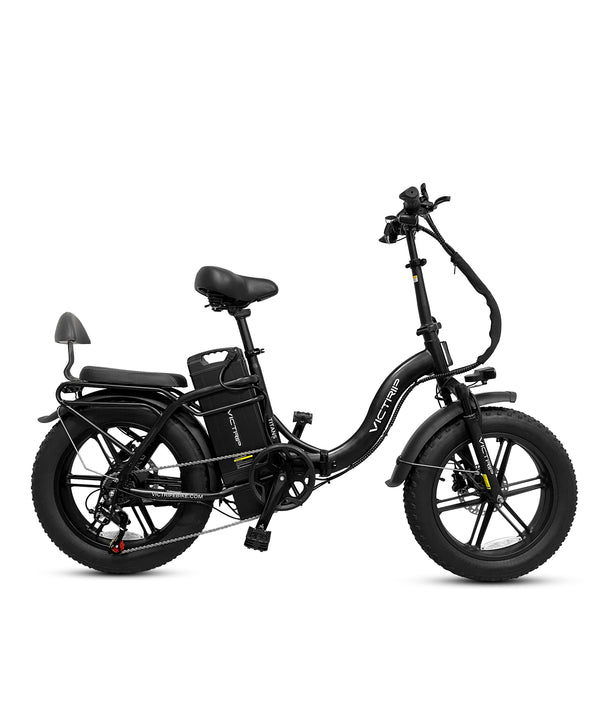
VICTRIP® TITAN S Foldable Ebike
Advantages of Fat Tires
-
All-Terrain Capability: Whether you're riding through muddy trails, sandy beaches, or snowy fields, fat tires provide reliable traction and control.
-
Increased Stability: The wide surface area distributes weight evenly, making it easier for beginners to balance.
-
Shock Absorption: Natural cushioning reduces the impact of bumps and rocky trails, offering a smoother ride.
Downsides of Fat Tire E-Bikes
-
Heavier Weight: They tend to weigh 60–80 lbs, making them harder to transport or lift.
-
Lower Top Speed: The increased rolling resistance slows them down on paved surfaces.
-
Shorter Battery Range: Due to the drag and weight, battery efficiency drops compared to thinner tires.
What Are Thin-Tire E-Bikes?
Thin-tire e-bikes, often resembling traditional road or commuter bicycles, are designed for speed, efficiency, and urban maneuverability. Tire widths usually range from 1 to 2.5 inches.
A notable model in this class is the VICTRIP Surnat S10, a sleek and agile commuter e-bike. It combines a minimalist design with performance features ideal for city streets and paved roads.
TOP PICK
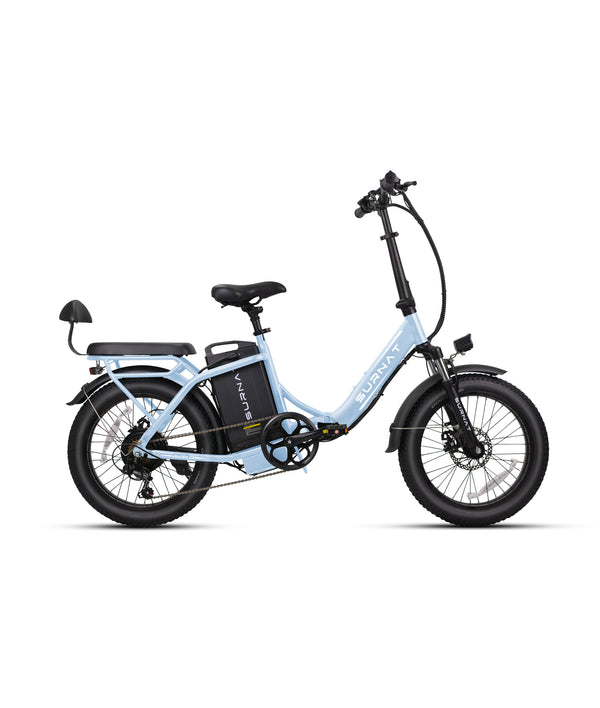
VICTRIP®SURNAT S10&S10-1 Ebike
Key Features of Thin-Tire E-Bikes
-
Lightweight frames and narrow wheels
-
Optimized for pavement and smooth surfaces
-
Higher speeds and longer range
-
Sleek, minimalist design
Why Choose the VICTRIP Surnat S10?
-
Tire Size: 700C x 35C for fast-rolling efficiency
-
Motor Efficiency: 500W brushless motor for zippy acceleration
-
Commuter Friendly: Integrated lights, fenders, and rear rack
-
Battery Range: Up to 70 miles in pedal-assist mode
If your goal is fast, efficient, and stylish commuting, the Surnat S10 is engineered for daily use in cities and suburbs.
Benefits of Thin Tires
-
Faster Commutes: Less rolling resistance translates to higher speeds with less effort.
-
Greater Range: Efficient use of battery power allows for longer rides per charge.
-
Compact and Portable: Easier to carry, store, and mount on bike racks.
Limitations of Thin-Tire E-Bikes
-
Limited Terrain Use: Not ideal for rough or slippery surfaces like snow or sand.
-
Reduced Stability: Narrow tires can wobble or slip in uneven conditions.
-
Less Shock Absorption: Riders may feel more of the road’s imperfections.
Fat Tire vs. Thin Tire: 7 Key Differences
Let’s compare these two e-bike types across essential performance and lifestyle factors:
1. Terrain Capability
| Feature | Fat Tire | Thin Tire |
|---|---|---|
| Best For | Off-road, trails, sand, snow | Paved roads, city paths |
| Grip | High | Moderate |
| Versatility | Excellent | Limited |
2. Comfort and Suspension
Fat tire ebikes naturally provide a cushioned ride thanks to air volume. While many come with front suspension, some offer full suspension setups, ideal for rough terrain. Thin-tire e-bikes rely more on built-in frame geometry and saddle design for comfort, which may not be enough on bumpy roads.
3. Speed and Efficiency
Thin tires generate less friction, meaning they go faster with less pedal effort. Fat tires, while powerful, create more drag and therefore consume more energy at the same speed.
4. Battery Range
Fat tire e-bikes typically offer 20–50 miles per charge depending on terrain. Thin-tire bikes can often push 40–70 miles or more, especially on flat urban routes. The difference lies in weight, aerodynamics, and rolling resistance.
5. Weight and Portability
Thin-tire models can weigh 30–45 lbs, while fat-tire e-bikes often exceed 65 lbs. If you live in an apartment or need to haul your e-bike onto a bus or car rack, the lighter frame of a thin-tire model may be preferable.
6. Maintenance Needs
Fat tires can be more demanding due to their size and specialized parts. Thin tires are often easier to replace and require less frequent service. However, fat tires are generally more durable against punctures.
7. Pricing and Value
Fat tire e-bikes usually start at a higher price due to their advanced frames, suspension, and motors. Thin-tire models come in a wide price range, making them more accessible for casual riders.

How to Choose Between Fat and Thin Tires
Lifestyle Considerations
Ask yourself:
-
Do I want an adventure-ready e-bike?
-
Am I commuting daily in an urban environment?
-
Do I prioritize speed or comfort?
Commuting vs. Adventure Riding
| Rider Type | Recommended E-Bike |
|---|---|
| Daily Commuter | Thin-tire E-Bike |
| Trail Explorer | Fat Tire E-Bike |
| Weekend Warrior | Depends on terrain |
Real-World Use Cases: Which One Performs Better?
Urban Environments
In city environments with traffic lights, crowded bike lanes, and narrow alleys, the VICTRIP Surnat S10 truly shines. Its slim tires, responsive handling, and long battery life make it ideal for quick stops, starts, and weaving through traffic.
Off-Road Trails
The VICTRIP Titan S dominates on gravel, forest trails, and uneven paths. Thanks to its thick tires and strong motor, it keeps you in control even on wet or rocky terrain.
Beach, Snow, and Sand
This is the natural territory of the Titan S. Fat tires like its 26x4.0” setup float on top of soft terrain, making it the preferred choice for coastal or winter rides.
Fat Tire and Thin-Tire E-Bikes for Beginners
Fat tire e-bikes are often more forgiving to learn on due to stability. However, thin tires offer more control on predictable surfaces, making them a good choice for urban beginners.
Are Fat Tire E-Bikes Harder to Ride?
Not exactly — they’re just different. The weight may surprise some users, and the handling feels slower. But once you're used to it, they’re incredibly fun and capable.
Conclusion: Which One Should You Buy?
The decision comes down to how, where, and why you ride.
-
Choose a fat tire e-bike if you love exploring, ride off-road, or need year-round traction.
-
Choose a thin-tire e-bike if you're commuting, value speed, and mostly stick to paved surfaces.
Both types offer unique advantages, and both are powerful tools for fun, freedom, and sustainability.
FAQs
1. Are fat tire e-bikes good for commuting?
They can be, especially in cities with bad roads or unpredictable weather. However, they’re heavier and slower than thin-tire options.
2. Do fat tires drain battery faster?
Yes, due to greater rolling resistance and weight. Expect a shorter range unless using a high-capacity battery.
3. Can I switch tire types on my e-bike?
Usually no. Fat and thin tires require different frames, fork widths, and wheel sizes.
4. Which is better for long-distance rides?
Thin tires are more efficient for long distances on smooth surfaces. Fat tires are better for long mixed-terrain adventures.
5. Do fat tires need special maintenance?
Not necessarily, but they may require higher inflation pressures and more frequent checks for wear due to the terrain they’re used on.

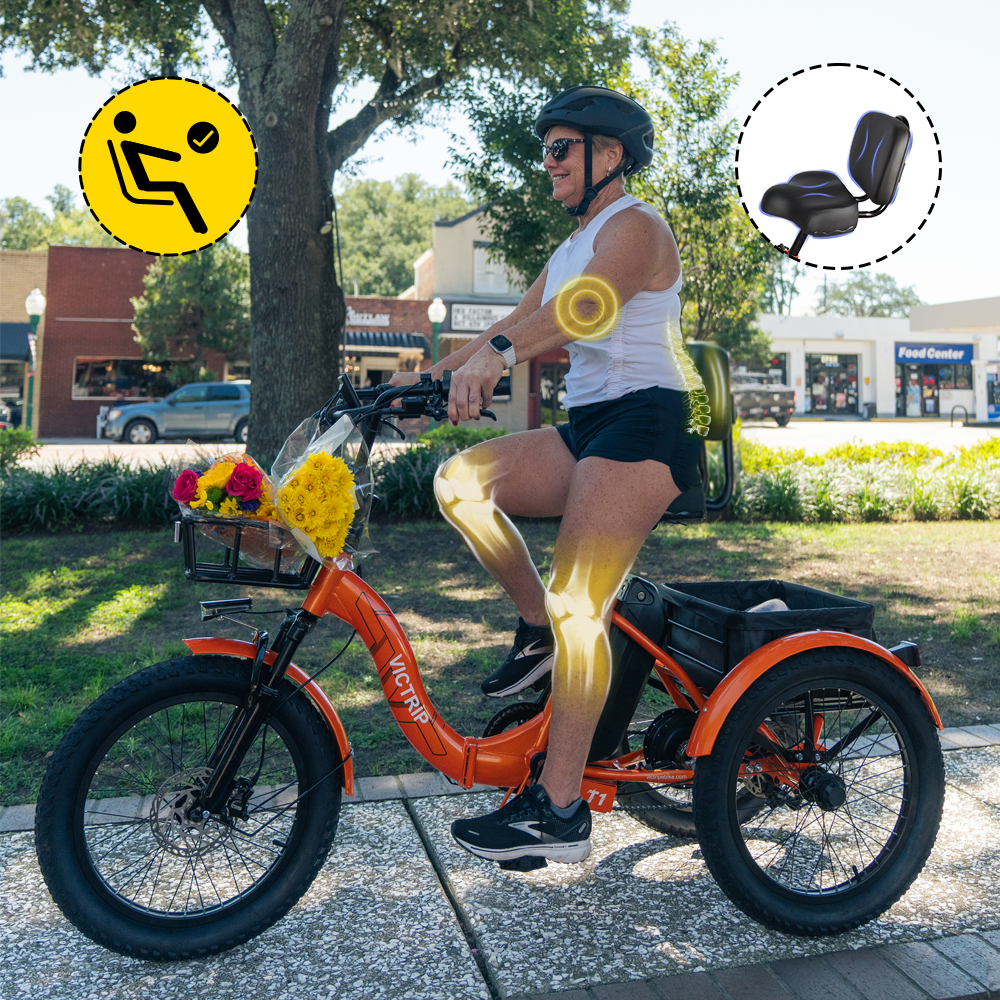
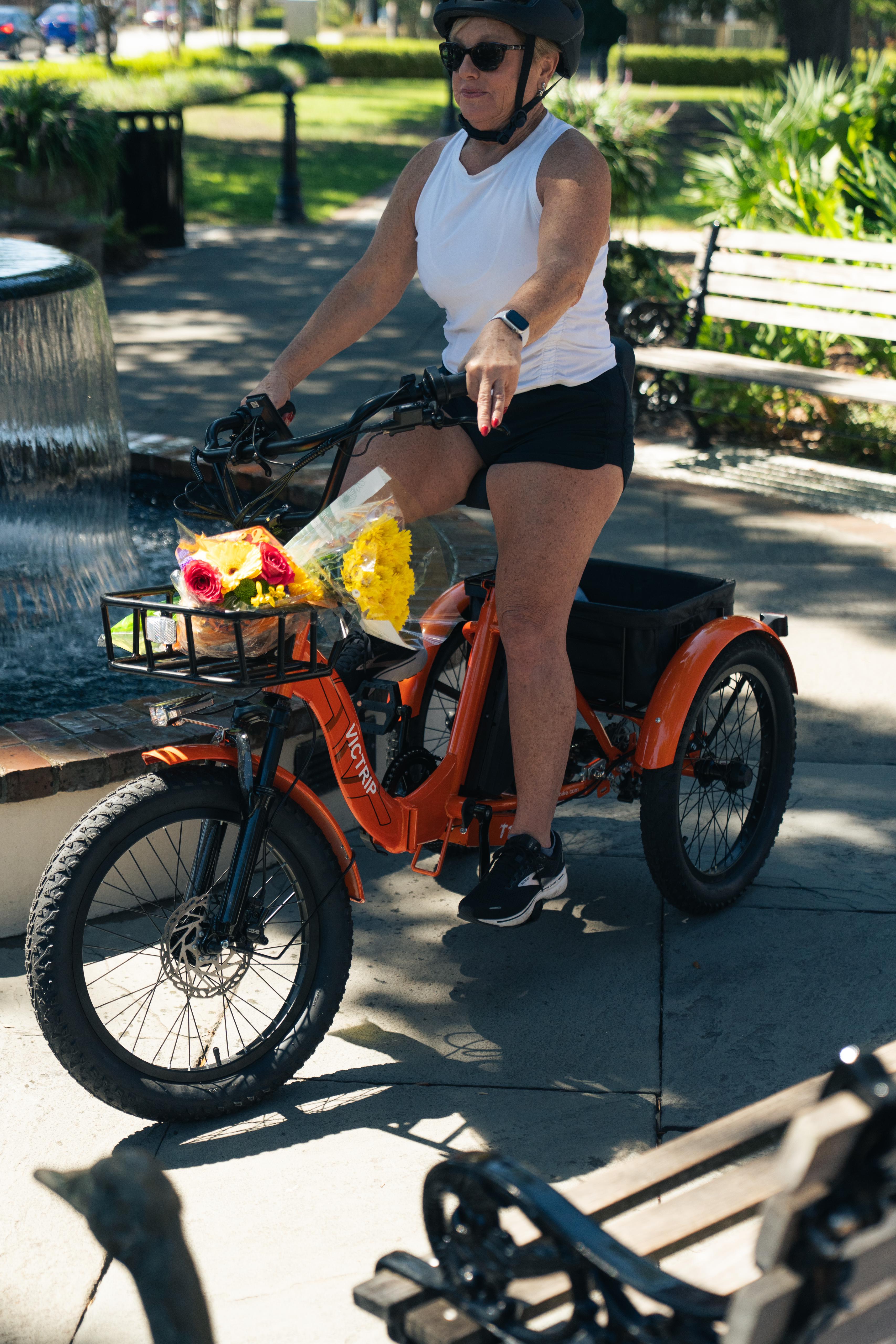
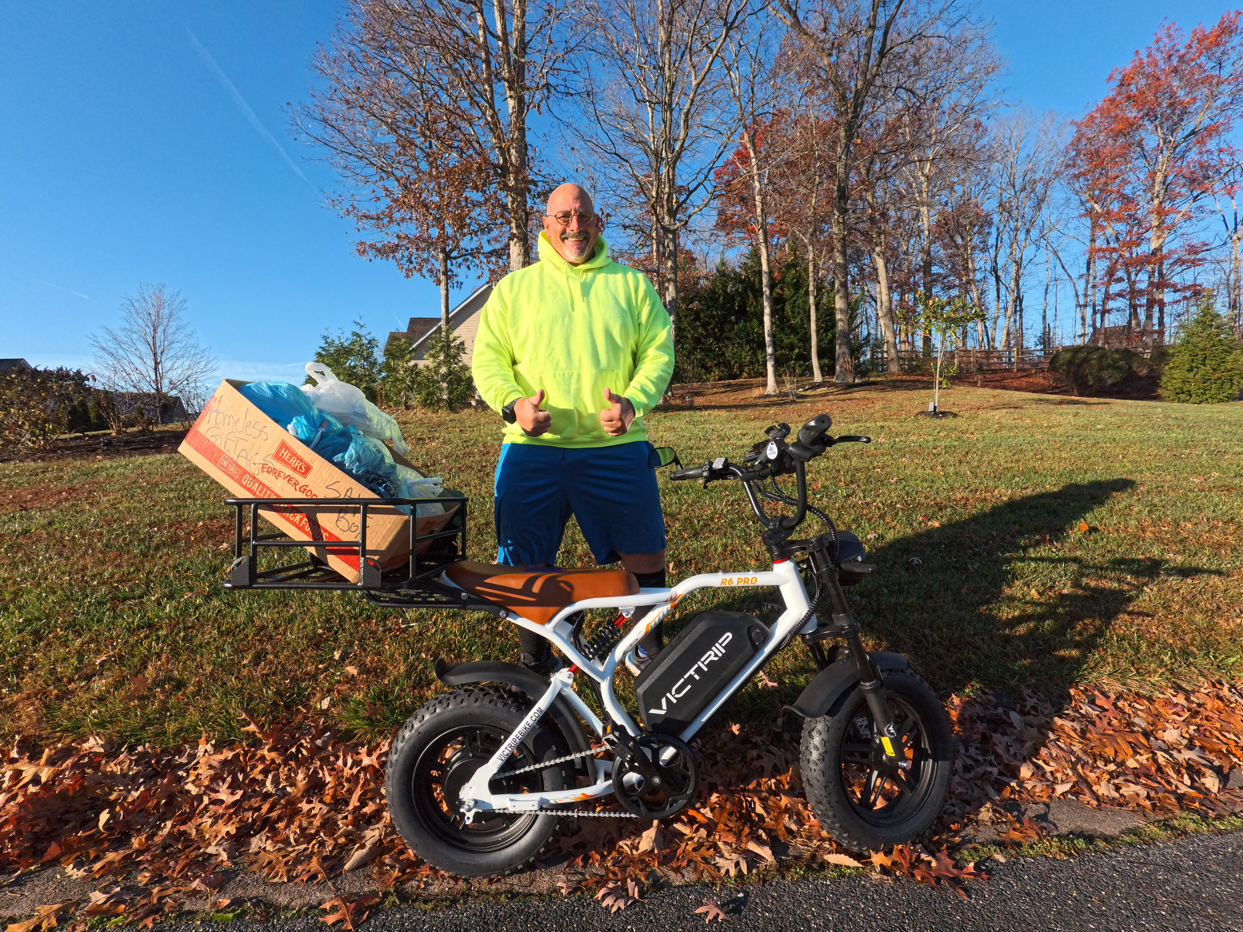
Share:
What Is A Class 3 Ebike?
How Long Do eBike Batteries Last? Lifespan, Tips & Myths